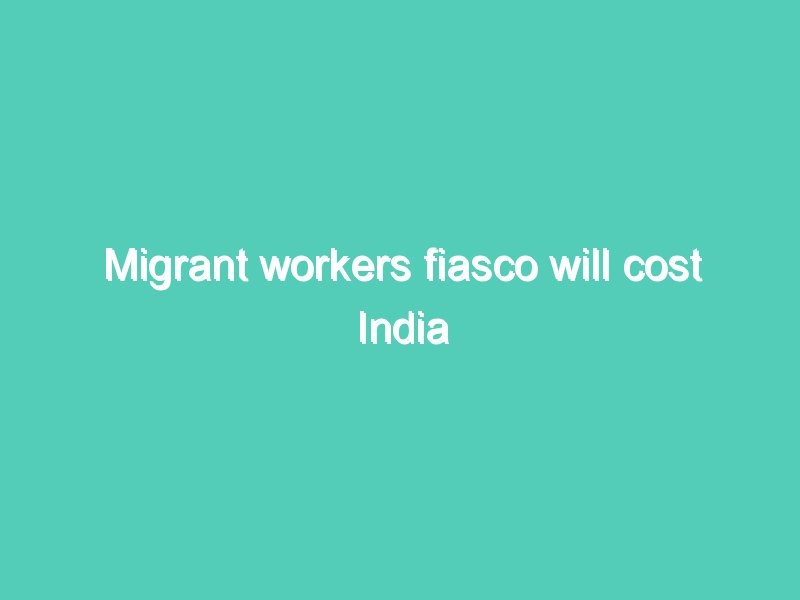The battle against the corona virus pandemic appears to have denied us of our humankind. The tragic horrible occurrence of 16 migrants being cut down under a goods train in Maharashtra on May 8 brings up a few issues on the versatility of migrants The following day, five migrants from a gathering of 11, were squashed to death under a truck in Madhya Pradesh. Furthermore, this end of the week (May 16), two trucks impacted and slaughtered at any rate 24 migrant workers and harmed 37 in Uttar Pradesh. The spate of mishaps enlightens us regarding the unfeeling conditions as well as of congestion, absence of security and the distress that is driving individuals to escape.
“ Their simple dream was to reach home; they were crushed somewhere along the wastelands they were trekking or ferrying a ride to get to their village. The incidents are a big slap on civilisation itself and, of course, on the development that we claim to have achieved. There are millions of migrants stuck in different parts of the country, and each one has endured unlimited misery amidst uncertainty. The Prime Minister’s announcement on May 12 of a massive relief package had a one-line passing mention of migrant labourers, which is the burning issue of the day and has driven many ordinary Indians to tears. Estimated 20-25 lakh migrants from Uttar Pradesh, 10-15 lakh migrants from Bihar and another 20-25 lakh migrants from other parts of India are in the COVID-19 hot zones of just Mumbai, Pune and Thane. We have no experience in dealing with the consequences of such large-scale movement of people.””
Consider how the picture has reversed. India was considered fortunate as it had the experiences of successes and failures of several other countries in dealing with the COVID-19 pandemic along with two months’ lead time for preparedness. Unprecedentedly, the entire nation was united then in the hope that we will end up as a totally different country vis-à-vis COVID-19. India’s proactive lockdown was acclaimed globally as the largest and strongest lockdown and earned accolades from the world’s most prestigious medical journal – The Lancet, in a special editorial on India. We can debate some decisions and actions taken in retrospect. But the way we have dealt with migrants is unconscionable.””
“The question we need to ask is, what was the epidemiological advantage of our actions? If the migrants, especially the casual labourers, having lost their wages, were anyways going to go, it was certainly advantageous -– scientifically as well as logistically — to send them either prior to or immediately after the lockdown. A simple perusal of figures tells us this. As against 536 COVID-19 cases and only 10 deaths in India till March 24, India had over 85,000 cases 2,200 deaths on May 16. In just a day, 52 COVID-19 infections on May 3 in the Mumbai suburb of Mulund jumped to 123 the next day. COVID-19 infections in Dharavi slums had crossed 632 on May 4, more than the entire country’s infections 40 days back. Hence, the workers migrating 50 days later will be migrating with 100 times more chance of COVID-19 infections than on March 24.”
“Most of them were on the streets or in slums, where social distancing is just another dream. A few lucky ones got the shade of community centres or quarantine centres. However, all were without wages with nothing to do but to wait for the next meal from the government agencies or some good Samaritans, and any possibility to get a transport back home. If they had been sent home around March 24, public opinion was on their side and the transport system was still in action then. And many would have probably come back happily to work once the lockdown is lifted. During lockdown 3.0, the government finally agreed to let them move, but with lots of pre-conditions and ambiguities. Yet, barely 500,000 migrants were transported with all manner of conditions and certificates asked of them, which led to overcrowding at police stations and at doctors’ clinics. Even on Saturday, there was a line at Mumbai’s main CST station, stretching several kilometres as workers wait in hope for the trains to re-start.”
“We expect migrants to pay for travel home, when they are left with no money. On the other hand, the government paid the costs for evacuating Indians from international destinations in March. Similarly, several state governments footed the bill to transport students from Kota in April. If not all, most of them could afford to pay for their travel and transport. Ironically, the Prime Minister appeals to the states, industry, businesses, philanthropists and common people to look after migrants and those in need. Why then did his government make the migrants pay for their travel back home? Aren’t these clear cases of double standards? Aren’t we treating the poor, hapless and voiceless people differently as lesser citizens, if not slaves?”
“The recipient states laid down several preconditions, including impractical ones like COVID-19 tests. No such conditions were laid down when the states picked-up the IIT preparatory students from Kota just a few days back. Harassing poor migrants to fill up forms, get mandatory medical fitness certificates by paying through their nose and that too for an endless wait due to the uncertainty of when their turn would come for train or road travel is demeaning, besides creating chaotic situations everywhere. If the travel is delayed, fresh medical certificates will be required. The queues outside clinics or hospitals, police stations, railway stations or bus terminals are perfect, uncontrollable COVID-19 transmission points where social distancing and hand hygiene went for a toss. When anyway they are to be put in 14-day quarantine at the places they will alight, why all this fuss?[1]”
“ There was a stampede by migrant workers in Surat that led to lathi-charge and tear-gassing by the police to disperse the mobs. We must feel ashamed that this is the way human beings – and those whose toil has built our cities and their services — have been treated in our country. The actions have important implications for our fight against COVID-19. If the disease spreads to the vast corners of India, the way we handled migrant workers would have certainly played an important part. We may end up paying a high price.”
Article Written By- Lavanya Ambalkar
Law Student– Symbiosis Law school, Pune
(HRDI Work From Home Internship)
[1] https://www.deccanherald.com/specials/sunday-spotlight/migrant-workers-fiasco-will-cost-india-dear-838550.html



